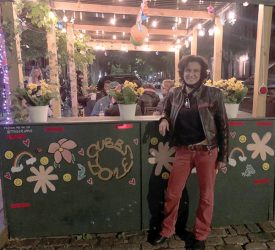By Karen Rempel
“People make their own faces and Larry knew this instinctively.” David Hockney wrote this two years after his friend’s death, describing Larry Stanton’s talent for portraiture. Larry was part of the wave of New York gay men tragically struck down by AIDS in the early 1980s. Larry died at St. Vincent’s Hospital in 1984.

Larry’s subjects were among the earliest victims of the AIDS pandemic. His intimate portraits of young men in their prime are laced with a solemnity that underscores the fact that many knew they were living on borrowed time. Their eyes reveal a horrifying truth: the knowledge that they and many of their loved ones were not long for this world.
Daniel Cooney Fine Art is showing an exhibition of Larry Stanton’s work titled It Doesn’t Thunder Every Day, now until July 1, 2021. The exhibit features some 20 works on paper in colored pencil and pastel that capture the face of a lost generation just as the AIDS epidemic was in its early stages.
Larry’s mentor and lover, West Village author and photographer Arthur Lambert, recalls Larry’s wish to be remembered. “For me, his death was a personal blow beyond the loss of an artist whose work I admired. For eighteen years he was the person I loved and my closest companion. One day in the hospital he tried to think of something that would cause me to remember him when he was gone and my memory of him had dimmed. After reflecting for a moment, he said, “I know, think of me when it thunders.” It sounded like a good idea but it hasn’t worked out as we expected. It doesn’t thunder every day.”
Daniel Cooney Fine Art | 508 – 526 West 26th Street, #9C, New York, NY 10001 | (212) 255 8158 | Hours: Wednesday – Saturday 11-6 | dan@danielcooneyfineart.com | View more of Larry’s work at larrystanton.net


For the record, the portrait selected for this article is of me. It was an unfortunate choice for illustrating the theme of this article because my eyes certainly revealed no feelings about the devastation to come. It was April 1981 (the date’s there on the portrait), the month before I and almost everybody else would begin learning about what would later become known as AIDS.
In addition, I also gather from the gallery’s website that this wasn’t among the portraits included in the exhbition!
Harlan, I wish that I had known of your existence when I was working on my book ‘Takedown Portraits,’ about Larry’s paintings and drawings. I used comments from Arthur to track down many sitters, but was unable to get anyone to talk about the experience. So I had to imagine the conversations. Best, Winthrop